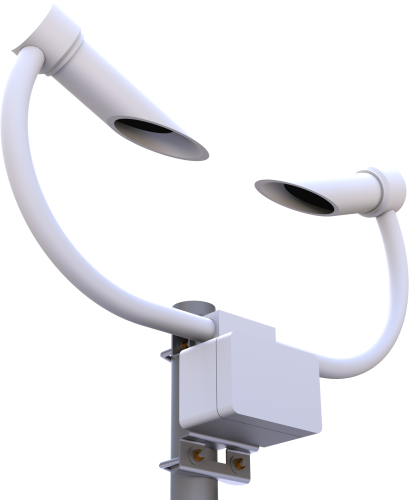This product is not available for new orders. We recommend ordering: CS120A.

| Services Available | |
|---|---|
| Repair | Yes |
| Calibration | Yes |
| Free Support | Yes |
Overview
The CS120 uses tried-and-tested, infrared forward-scatter technology, and uses the proven 42° scatter angle to report meteorological observable range (MOR) for fog and snow in the range 10 to 30,000 m. It combines a high specification with a very competitive price. The CS120 is ideal for stand-alone applications or in combination with automatic weather stations in road, aviation, solar-energy, and wind-energy environments.
Note: Campbell Scientific does not recommend using the CS120 for marine applications.
Read MoreBenefits and Features
- High-performance sensor at a competitive price
- Incorporates automatic dew and hood heaters for all-weather operation
- Simple field calibration using optional calibration kit
- Low power - suitable for remote applications
- Automatic status check for faults or window contamination
- Sensor design minimizes airflow disruption at measurement volume
Images



Detailed Description
Compared to many such sensors the CS120 design means that visibility is being measured in a relatively clean space because the position of the heads and body minimize disturbance of the airflow at the measurement volume.
The CS120 uses continuous high-speed sampling, which improves the accuracy of the measurements taken during mixed weather such as rain and hail, while providing reliable readings during more stable events such as fog and mist. High speed sampling also allows the sensor to better respond to suddenly changing conditions.
The CS120 has several design features that keep its optics clean. Downward facing optics minimizes dirt and snow build up. Low powered heaters prevent the formation of dew, and a higher-powered heater prevents the formation of ice.
The sensor is very power efficient, drawing just 3 W during normal operation including the dew heaters; power can be reduced further by reducing the sample rate and manual control of the heaters.
Compatibility
Please note: The following shows notable compatibility information. It is not a comprehensive list of all compatible products.
Specifications
| Measurement Description | Meteorological Observable Range (MOR) |
| Signal Type/Output | RS-232, RS-485 |
| Maximum Reported Visibility | 32 km (~20 mi) |
| Minimum Reported Visibility | 12 m (~39 ft) |
| Accuracy (0 to 10,000 m) | ±10% |
| Accuracy (10,000 to 20,000 m) | ±20% |
| Operating Temperature | -25° to +60°C |
| Operating Humidity | 0 to 100% |
| Wind Speed | Up to 60 m/s |
| Sensor Sealing | Rated to IP66 |
| Mounting | Stainless-steel V-bolt mounting to pole with OD of 32 to 52.5 mm (1.25 to 2 in.) |
| Dimensions | 447 x 640 x 246 mm (17.6 x 25.2 x 9.7 in.) |
| Weight | ~3 kg (6.6 lb) depending upon mounting system used |
Electrical |
|
| -NOTE- |
|
| Electronic Supply Voltage | 8 to 30 Vdc |
| Hood Heater Supply Voltage | 24 Vdc or Vac |
| Hood Heater Power | 2 x 30 W (total of 60 W) |
| Total Unit Power | < 3 W while sampling continuously (including dew heaters) |
Interface |
|
| Serial Interface | RS-232 or RS-485 |
| Serial Data Rates | 1200 to 115,200 bps (38,400 bps default rate) |
| Alarm Outputs | 2 x 0 to 5 V outputs, 32 mA (max) |
Optical |
|
| Emitter Light Frequency | 850 nm |
| Lens Contamination Circuitry | Monitors both the source and detector lenses for contamination/blockage at 1 s intervals. Sensor adjusts its calibration for low to moderate window contamination. |
| Light Source Stability Control | Ensures stable operation through variations in temperature and with sensor aging. Corrected at 1 s intervals. |
Related Documents
Product Brochures
Downloads
CS120 Firmware v.6 (1.51 MB) 10-08-2012
Includes the current CS120 firmware and the CS120 support files for the Device Configuration Utility.